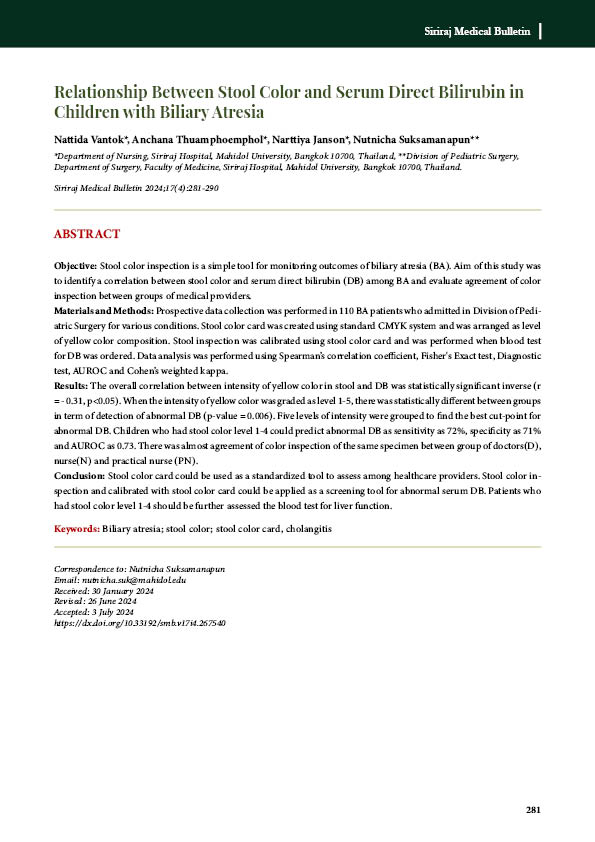Relationship Between Stool Color and Serum Direct Bilirubin in Children with Biliary Atresia
Main Article Content
Abstract
Objective: Stool color inspection is a simple tool for monitoring outcomes of biliary atresia (BA). Aim of this study was to identify a correlation between stool color and serum direct bilirubin (DB) among BA and evaluate agreement of color inspection between groups of medical providers.
Materials and Methods: Prospective data collection was performed in 110 BA patients who admitted in Division of Pediatric Surgery for various conditions. Stool color card was created using standard CMYK system and was arranged as level of yellow color composition. Stool inspection was calibrated using stool color card and was performed when blood test for DB was ordered. Data analysis was performed using Spearman’s correlation coefficient, Fisher's Exact test, Diagnostic test, AUROC and Cohen’s weighted kappa.
Results: The overall correlation between intensity of yellow color in stool and DB was statistically significant inverse (r = - 0.31, p<0.05). When the intensity of yellow color was graded as level 1-5, there was statistically different between groups in term of detection of abnormal DB (p-value = 0.006). Five levels of intensity were grouped to find the best cut-point for abnormal DB. Children who had stool color level 1-4 could predict abnormal DB as sensitivity as 72%, specificity as 71% and AUROC as 0.73. There was almost agreement of color inspection of the same specimen between group of doctors(D), nurse(N) and practical nurse (PN).
Conclusion: Stool color card could be used as a standardized tool to assess among healthcare providers. Stool color inspection and calibrated with stool color card could be applied as a screening tool for abnormal serum DB. Patients who had stool color level 1-4 should be further assessed the blood test for liver function.
Article Details

This work is licensed under a Creative Commons Attribution-NonCommercial-NoDerivatives 4.0 International License.
References
Hartley JL, Davenport M, Kelly DA. Biliary atresia. Lancet. 2009;374(9702):1704-13.
Hopkins PC, Yazigi N, Nylund CM. Incidence of Biliary Atresia and Timing of Hepatoportoenterostomy in the United States. J Pediatr. 2017;187:253-7.
Lee KJ, Kim JW, Moon JS, Ko JS. Epidemiology of Biliary Atresia in Korea. J Korean Med Sci. 2017;32(4):656-60.
Joel Cazares BU, and Atsuyuki Yamataka. Biliary atreia. In: George W. Holcomb III JPM, editor. Holcomb and Ashcraft's pediatric surgery. 7th ed. 2020. p. 679-91.
Shneider BL, Magee JC, Karpen SJ, Rand EB, Narkewicz MR, Bass LM, et al. Total Serum Bilirubin within 3 Months of Hepatoportoenterostomy Predicts Short-Term Outcomes in Biliary Atresia. J Pediatr. 2016;170:211-7. e1-2.
Calinescu AM, Madadi-Sanjani O, Mack C, Schreiber RA, Superina R, Kelly D, et al. Cholangitis Definition and Treatment after Kasai Hepatoportoenterostomy for Biliary Atresia: A Delphi Process and International Expert Panel. J Clin Med. 2022;11(3).
Vitek L, Majer F, Muchova L, Zelenka J, Jiraskova A, Branny P, et al. Identification of bilirubin reduction products formed by Clostridium perfringens isolated from human neonatal fecal flora. J Chromatogr B Analyt Technol Biomed Life Sci. 2006;833(2):149-57.
Hamoud AR, Weaver L, Stec DE, Hinds TD, Jr. Bilirubin in the Liver-Gut Signaling Axis. Trends Endocrinol Metab. 2018;29(3):140-50.
Chen SM, Chang MH, Du JC, Lin CC, Chen AC, Lee HC, et al. Screening for biliary atresia by infant stool color card in Taiwan. Pediatrics. 2006;117(4):1147-54.
Gu YH, Matsui A. Long-term native liver survival in infants with biliary atresia and use of a stool color card: Case-control study. Pediatr Int. 2017;59(11):1189-93.
Morinville V, Ahmed N, Ibberson C, Kovacs L, Kaczorowski J, Bryan S, et al. Home-Based Screening for Biliary Atresia Using Infant Stool Color Cards in Canada: Quebec Feasibility Study. J Pediatr Gastroenterol Nutr. 2016;62(4):536-41.
Witt M, Lindeboom J, Wijnja C, Kesler A, Keyzer-Dekker CM, Verkade HJ, et al. Early Detection of Neonatal Cholestasis: Inadequate Assessment of Stool Color by Parents and Primary Healthcare Doctors. Eur J Pediatr Surg. 2016;26(1):67-73.
Westland S, Cheung V. CMYK systems. Handbook of Visual Display Technology. 2016.
Hoshino E, Hayashi K, Suzuki M, Obatake M, Urayama KY, Nakano S, et al. An iPhone application using a novel stool color detection algorithm for biliary atresia screening. Pediatr Surg Int. 2017;33(10):1115-21.
Parinyanut P, Bandisak T, Chiengkriwate P, Tanthanuch S, Sangkhathat S. Digital camera image analysis of faeces in detection of cholestatic jaundice in infants. Afr J Paediatr Surg. 2016;13(3):131-5.
Graves R, Weaver SP. Cefdinir-associated "bloody stools" in an infant. J Am Board Fam Med. 2008;21(3):246-8.
Lancaster J, Sylvia LM, Schainker E. Nonbloody, red stools from coadministration of cefdinir and iron-supplemented infant formulas. Pharmacotherapy. 2008;28(5):678-81.
MacDonald CA. Biliary atresia. J Pediatr Nurs. 1991;6(6):374-83.






